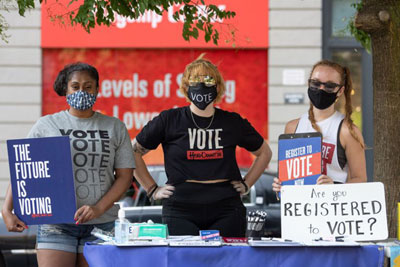
By Lauren Puckett
As of August 18, an entire century has passed since the ratification of the 19th Amendment, which granted the right for some women—but certainly not all—to vote. According to President Trump, who believes he’s done more for women than any other American president, the most one must do to commemorate such an occasion is pardon Susan B. Anthony, who was convicted of illegally voting in 1872. The irony, of course, is Trump has recently ignited fury over his public attempts to suppress mail-in ballots, a service that allows a wider demographic of women the ability to vote.
That’s why it feels so sticky to celebrate the 19th Amendment today. Fighting for a place at the polls has been a multi-century battle for women—women of color in particular. Restrictions prohibited Latina, Black, Asian-American, and Native-American women from voting until decades after the 19th Amendment was ratified. The Voting Rights Act of 1965 helped put a ballot in the hands of more women of color, but it didn’t solve the problem of long queues, restrictive voter ID laws, early closing times, or breakdowns in modern machinery, which can lead many voters—especially those in marginalized communities—to turn their backs on the polls, as we witnessed during the Georgia state primary.
Then in 2013, the Supreme Court gutted the Voting Rights Act with a landmark decision that ultimately allowed states and localities to change their voting process without federal approval, or preclearance. “Without preclearance requirements, states were free to enact aggressive measures reducing access to the polls and they did so with breakneck speed and efficiency following the Court’s decision,” journalist Melissa Harris-Perry wrote.
Although BIPOC suffragists have long been erased from the voting rights narrative in favor of white heroines (such as the aforementioned Susie B.), efforts by these women of color were and are instrumental to modern elections. They’ve taught us that buying more stamps is far from the only solution to combat voter suppression ahead of the 2020 election. In honor of the women who fought so hard for the 19th Amendment—and every milestone since its ratification—here’s what you can do to help their efforts.
EDUCATE YOURSELF.
To support a movement against voter suppression, it’s important to understand why the problem exists in the first place. “Even as we commemorate this milestone, it’s crucial that we acknowledge its complexity,” Melinda Gates told Fortune. “One way I’ve been grappling with this history is by reading more about the Black women activists who were unsung heroes in the movement for women’s voting rights.”
Most of those activists were sidelined in U.S. history, despite their work. “In school, students are often told the stories of Susan B. Anthony, Alice Paul, and Elizabeth Cady Stanton, and are shown pictures of white women activists wearing white dresses and holding up ‘Votes for Women’ signs, but Black women suffragists like Mary Church Terrell and Ida B. Wells are often excluded from the history books,” Leigh Chapman of The Leadership Conference on Civil & Human Rights told BAZAAR.


Be the first to comment